Best Time to Visit
Gran Canaria: Complete 2025
Month-by-Month Guide
Weather, crowds, prices and activities – choose the best time to visit Gran Canaria with my guide
By Liam Mulligan | Published on June 18, 2025 |Modified on June 18, 2025
The best time to visit Gran Canaria depends on your priorities, but the Canary Islands are known for their incredible year-round weather, and Gran Canaria is no different. Nicknamed the ‘Island of Eternal Spring’, the island benefits from over 300 days a year of sunshine with temperatures rarely below 18°C or above 30°C.
As someone who’s travelled extensively around Spain (check out my guide to the 20 Best Places To Visit In Spain For First-Timers), visiting Gran Canaria in the past and planning my own June trip this year, I know a thing or two about the best time to visit Gran Canaria. In this post, I’ll help you choose the perfect time based on your priorities – whether that’s escaping winter, finding the best value, or avoiding crowds.
I’ll be covering weather patterns, budget considerations, regional differences and the best seasons for different activities. Let’s start with the quick answer for those in a hurry, then dive deep into what makes each month special.

Best Times to Visit Gran Canaria at a Glance
For those short on time or just wanting a quick rundown, here are the straight-up facts to help you choose the best time to visit Gran Canaria quickly and efficiently:
| Your Priority | Best Months | Why Choose This Time |
| Best Overall | March-May & September-November | Perfect weather + good value + manageable crowds |
| Hottest Weather | July-August | 28-29°C daily highs, guaranteed sunshine |
| Warmest Sea | August-October | 22-24°C ideal for swimming & water sports |
| Best Value | March-April, October-November | 20-40% savings on accommodation |
| Fewest Crowds | November, January | Peaceful beaches, authentic experiences |
| Best for Hiking | October-May | 20-25°C perfect for outdoor adventures |
| Winter Sun Escape | December-February | December-February |
| Cultural Festivals | February (Carnival), June (San Juan) | February (Carnival), June (San Juan) |
Understanding Gran Canaria’s Year-Round Climate
Sitting 150km off the North African coast, Gran Canaria and its fellow Canary Islands enjoy fantastic weather all year-round. Those looking for a Spanish adventure will find consistent temperatures throughout the year, making it an ideal destination at any point of the year.
Understanding Gran Canaria’s weather patterns is key to planning the best time to visit Gran Canaria for your needs.
What Makes Gran Canaria’s Weather So Special?
The numbers tell the story: Gran Canaria benefits from a subtropical desert climate, bringing stable year-round temperatures. The island rarely experiences rainfall, with the annual average of 150mm being significantly less than the UK’s average of 1,200mm – that’s 8 times drier!
With cooling trade winds creating a constant gentle breeze, Gran Canaria enjoys some of the world’s most perfect year-round conditions.
Perfect Positioning
What makes this climate so special is Gran Canaria’s unique positioning. Located at 28°N latitude (the same as the Florida Keys), the island sits far enough from the African coast to avoid extreme desert heat while still benefiting from year-round warmth.
The surrounding Atlantic Ocean acts as a natural thermostat, with the cool Canary Current moderating temperatures and preventing the extreme highs you’d find at similar latitudes elsewhere.
Natural Climate Control
Unlike many destinations where seasons bring dramatic changes, Gran Canaria’s temperatures vary by just 8-10°C between winter and summer months. The constant northeast trade winds prevent air stagnation, while the island’s volcanic mountains create natural windbreaks that contribute to diverse microclimates across different regions.
This stability means Gran Canaria truly lives up to its “Eternal Spring” nickname! You can enjoy outdoor activities, from beach days to mountain hiking, any month of the year.
Regional Climate Differences You Need to Know
Despite being a relatively small island, there are notable climate differences across Gran Canaria that can significantly impact your trip. Understanding these variations is crucial when determining the best time to visit Gran Canaria for your specific needs.
The South Coast: Best Weather Guarantee
The south coast region, famous for its tourist beach resorts of Maspalomas, Puerto Rico, and Playa del Inglés, is typically 2-3°C warmer and receives less rainfall than other areas. This region offers the most reliable winter sun and protection from trade winds.
Those looking for guaranteed warm weather should make this their number one choice, especially during winter months.
The North Coast: Culture Meets Comfort
The north coast around the capital Las Palmas tends to be slightly cooler and sees more cloud cover. However, it’s still pleasantly warm year-round with the added benefits of authentic Canarian culture, excellent restaurants, and vibrant city life.
Summer visitors often prefer the north as temperatures are more comfortable than the sometimes intense southern heat.
The Mountains: Cool Alpine Alternative
The most dramatic temperature changes occur with altitude. As Gran Canaria is a volcanic island, the mountainous interior offers much cooler conditions, perfect for hiking and escaping coastal heat.
Temperatures drop by approximately 6°C per 1,000m of elevation. The central peaks can be 10-15°C cooler than the southern coast, with significantly more rainfall and occasional mist.
This creates a fascinating phenomenon where you can experience Mediterranean beaches and dramatic volcanic landscapes on the same day, perfect for adventurous travellers seeking variety.
Important Weather Phenomena
Two weather events are worth knowing about before you visit.
Calima occurs when hot, dusty winds blow in from the Sahara Desert, creating hazy conditions that can last 2-3 days and may affect those with respiratory issues.
Trade winds are generally beneficial, providing cooling relief, but can occasionally bring stronger gusts to exposed coastal areas, particularly in summer.
Month-by-Month Guide to Visiting Gran Canaria
Summer in Gran Canaria (June-August) brings the hottest temperatures and busiest beaches of the year. This is when the island truly buzzes with energy, from packed waterfront restaurants to vibrant beach scenes and long, sun-soaked days that stretch well into the evening.
While you’ll pay premium prices and share the coastline with fellow sun-seekers, there’s something magical about Gran Canaria in full summer swing. The sea reaches its most comfortable temperatures, outdoor events fill the calendar, and the island’s famous nightlife comes alive.
If you don’t mind crowds and can handle the heat, summer offers the quintessential Canarian experience – remember to book everything well in advance.
June in Gran Canaria
June is when Gran Canaria truly comes alive. With average temperatures of 27°C during the day and a comfortable 21°C at night, it’s warm enough for beach days but not oppressively hot.
The sea reaches a perfect 22°C – ideal for swimming and water sports.
Why June Works So Well
As someone visiting in June myself, I chose this month for good reason. The weather is perfect for sunbathing and exploring the island without oppressive heat. Although it’s summer, heading to Gran Canaria outside of school holidays means we managed to find a deal – £350 for a week in Maspalomas wasn’t something we were going to let pass by!

Perfect Conditions for Activities
With the excellent weather, June is perfect for beach activities and water sports. The evenings stay warm – ideal for outdoor dining at Gran Canaria’s excellent restaurants.
The island comes alive with a vibrant summer buzz.
The Trade-offs
The downside of June’s perfect weather is that everyone knows about it. While not as busy as July and August, expect moderate to high crowds. If you’re seeking a quiet getaway, June might not be ideal.
What to Pack
Packing for June is simple – leave heavy clothes at home and focus on t-shirts, shorts, swimwear, and just a light jacket. Don’t forget high SPF sunscreen as the UV is strong.
Cultural Highlights
June kicks off Gran Canaria’s summer festival season, highlighted by the magical San Juan celebrations on June 23rd, when locals gather on beaches for bonfires and the tradition of jumping over flames for good luck.
Choose June if you want guaranteed sunshine, don’t mind crowds, but want fewer tourists than peak summer, and love beach-centric holidays. It’s the perfect month for excellent weather and value.
July in Gran Canaria
July brings peak summer heat to Gran Canaria. With highs of 28°C and lows of 22°C, plus sea temperatures reaching a balmy 23°C, this is a beach lover’s paradise.
You’ll enjoy 11+ hours of sunshine daily with virtually no rainfall – guaranteed perfect beach weather.
Peak Season Reality
With the perfect weather comes peak European holiday season, bringing very high crowds and premium pricing. July is one of Gran Canaria’s most expensive months, so book accommodation and restaurants months in advance to secure the best spots.
The upside? The island has an incredible buzzing summer atmosphere that’s infectious.

Ideal Activities
July is ideal for beach time and water sports, with the warmest sea temperatures of the year. The evenings stay pleasantly warm, perfect for dining al fresco at Gran Canaria’s excellent restaurants.
Beating the Heat
The heat peaks in the afternoon (12pm-4pm), so embrace the Spanish siesta culture and plan sightseeing for early morning or late evening to stay comfortable.
Packing Essentials
Packing for July is simple with the hot weather. Focus on minimal, breathable clothing – cotton and linen shorts, t-shirts, and dresses are ideal. Don’t forget sun protection essentials: high SPF sunscreen, sun hats, and sunglasses.
Pro Tip – Bring a refillable water bottle for pool and beach days – staying hydrated is crucial in July’s heat.
Summer Celebrations
July brings Gran Canaria to life with buzzing nightlife and vibrant summer energy. The island hosts numerous summer festivals, including the important Fiesta del Carmen on July 16th – a celebration honouring the patron saint of fishermen with colourful processions and beachside festivities.
The larger crowds create an infectious party atmosphere throughout the island.
Choose July if you want guaranteed hottest weather, don’t mind crowds and premium prices, and love the vibrant peak summer atmosphere. It’s perfect for beach lovers who want the warmest sea temperatures and longest days.
However, avoid July if you’re heat-sensitive, budget-conscious, or prefer peaceful holidays – the crowds and intensity can be overwhelming. For many visitors, July’s infectious energy and perfect beach conditions make it worth the extra cost.
August in Gran Canaria
August is Gran Canaria’s hottest month, with daily highs of 29°C and temperatures rarely dropping below 23°C at night. The sea reaches its warmest annual temperature of 24°C, while maximum sunshine hours make this the ultimate month for serious beach lovers. If you thrive in hot weather and don’t mind the peak summer crowds, August delivers guaranteed scorching sunshine perfect for beach days and water activities.
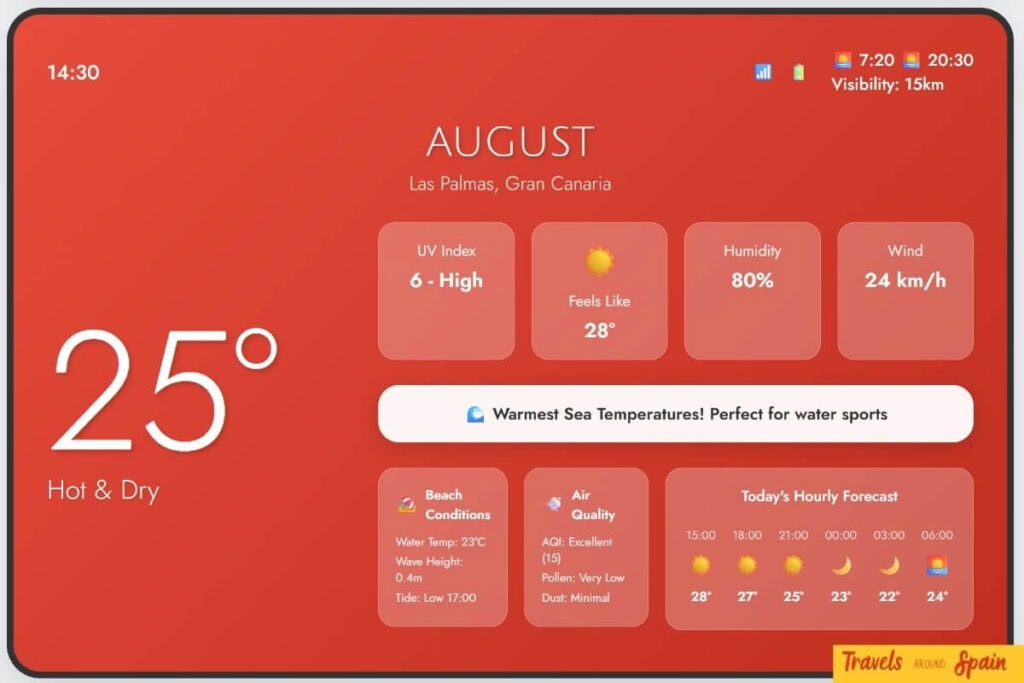
The fantastic weather combined with European school holidays makes August Gran Canaria’s busiest month. Families flock to the island, pushing up accommodation and flight prices significantly. Tours fill up quickly, so book everything in advance to avoid disappointment.
August is perfect for beach getaways. It doesn’t get better for spending time on beaches, swimming, and visiting water parks. However, avoid midday hiking and strenuous outdoor activities – the UV index is extreme. Follow the Spanish schedule: take a siesta from 2-5pm and explore during cooler evening hours.
Pack light, breathable clothing, high SPF sunscreen, and cooling accessories. For sightseeing, leave early morning or visit sites in the evening. Book restaurant reservations early as everything fills up.
August brings village fiestas throughout the island, beach parties, and Gran Canaria’s nightlife at its peak. If you want a vibrant, energetic atmosphere, August delivers.
Choose August if you love guaranteed heat and don’t mind paying premium prices. Perfect for beach lovers, families, and party-goers, but consider other months if you prefer quieter, budget-friendly travel.
Autumn Season: Warm Seas and Fewer Crowds
If summer’s heat and crowds sound overwhelming, autumn might be Gran Canaria’s best-kept secret. September through November offers a compelling alternative: the sea is at its absolute warmest after months of summer heating, yet the tourist masses begin to thin out and prices become more reasonable.
September feels like summer’s encore – still gloriously warm but without the intensity of peak season. October strikes the perfect balance with ideal hiking weather returning and genuinely good value for money. November brings the year’s best bargains, though the weather becomes more variable.
This is when many seasoned travellers choose to visit Gran Canaria. You’ll experience the island at a more relaxed pace, with easier restaurant bookings, less crowded beaches, and that wonderful feeling of having discovered something special. The Spanish locals are also more relaxed after the summer, making it an ideal time to experience authentic Canarian culture.
September in Gran Canaria
Heading into shoulder season, September in Gran Canaria is still a great option. Average day temperatures stay around the 27°C mark with nights averaging 22°C. After months of summer heating, the sea is at its warmest year-round temperature of 24°C – it’s still warm but more comfortable than peak summer. With minimal rainfall and excellent sunshine, September definitely deserves serious consideration.
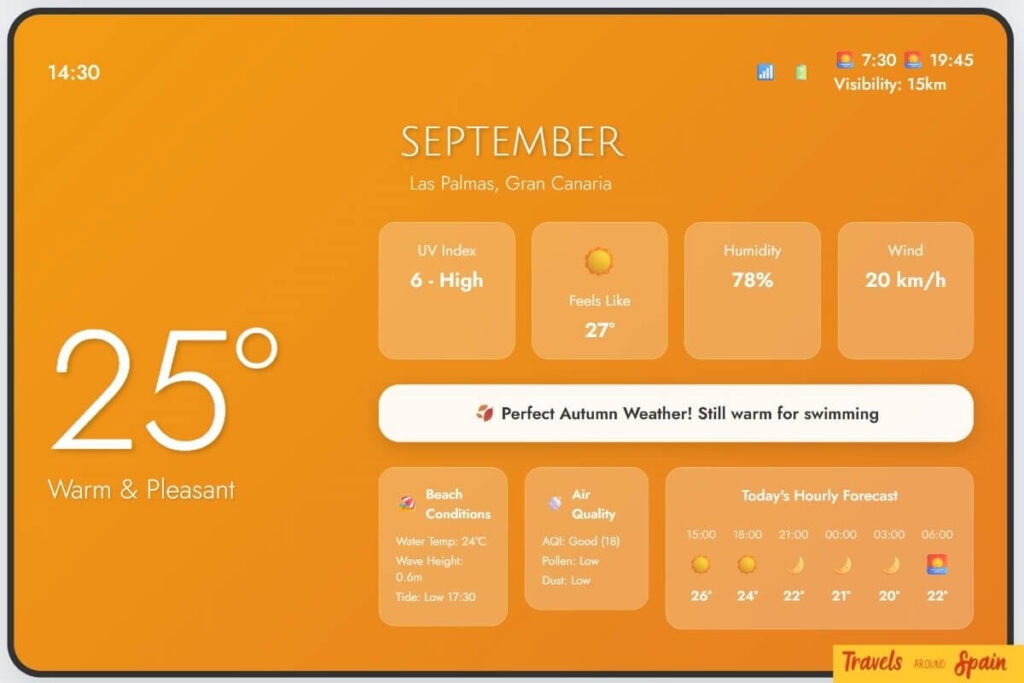
September is a month of two halves. Early September remains busy with people extending summer holidays and peak pricing continues until mid-month. The sweet spot comes in the second half when crowds disperse but weather stays excellent.
September is perfect for beach lovers and water sports with the year’s warmest sea temperatures. Mountain hiking becomes possible again as temperatures cool, while clearer skies create better photography conditions after summer haze fades.
Pack summer clothes with light evening layers as nights begin to cool. You’ll have less pressure booking tours but still reserve popular restaurants in advance.
Fiesta del Charco takes place on September 11th in the western part of the island. With fewer tourists, festivals feel more authentic – perfect for genuine Canarian experiences.
Choose September if you want the warmest seas, fewer crowds than summer, and better value. Perfect for swimming and post-summer relaxation.
October in Gran Canaria
October continues to be warm in Gran Canaria. With highs of 25°C and lows of 20°C, the weather offers the perfect balance. Sea temperatures remain warm at 22°C after all the summer heating, making it one of those “sweet spot” months – warm but not too hot.

With the summer period now over, October offers post-summer tranquillity. The crowds have gone home and shoulder season pricing kicks in, making bargains much easier to find. What’s more, the lower temperatures make hiking comfortable again after the oppressive summer heat.
October’s perfect conditions make it ideal for both beach and mountain activities. The warm sea is still excellent for swimming and water sports, while the cooler air temperatures make hiking through Gran Canaria’s interior a pleasure again. Outdoor dining becomes comfortable throughout the day, and you can enjoy sunset walks without the intense heat.

The end of summer brings a slight increase in rainfall though it remains minimal. With more changeable weather, pack light layers for temperature changes whilst also bringing your swimwear and sun protection.
Nothing highlights October’s status as a hiking month better than the Gran Canaria Walking Festival, a major hiking event taking in the island’s trails and views. Marathon season also begins, while harvest festivals in the wine regions offer a more relaxed alternative.
Choose October if you’re a hiker or active traveller who’ll love the cooler weather and beautiful landscapes. Budget-savvy travellers will appreciate the deals, while anyone seeking great weather without summer crowds will find this month perfect.
November in Gran Canaria
Remarkably the good weather continues into November. Highs of 23°C and lows of 18°C are some of the best temperatures in Europe. When you throw in that the sea temperature is 21°C, you have the perfect November winter sun destination. The weather can be changeable, but temperatures remain mild.
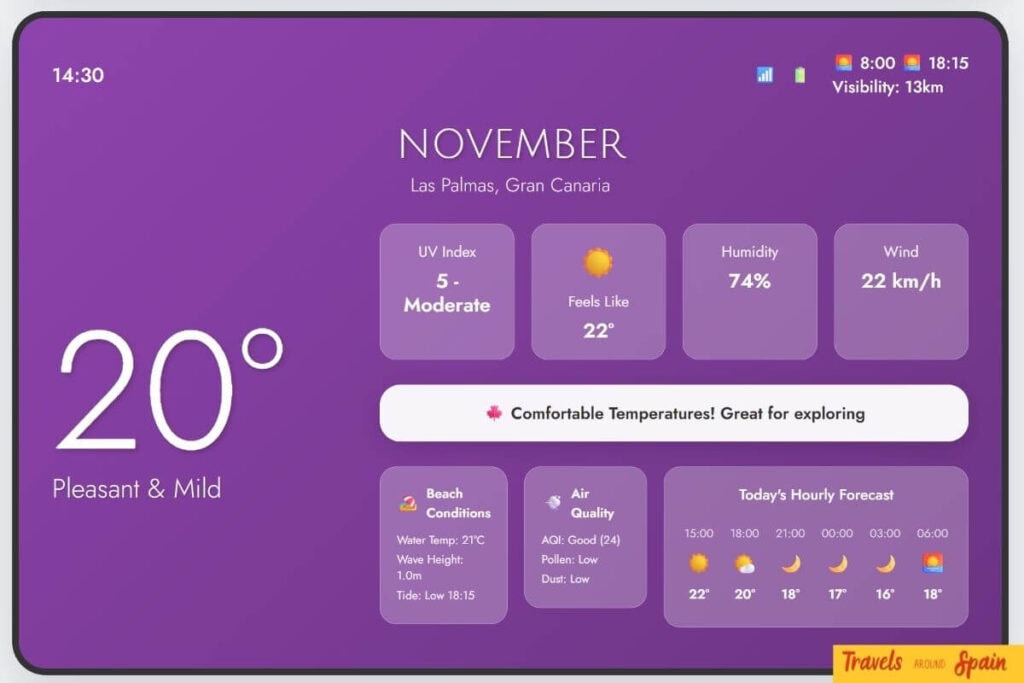
November has the lowest prices of the year for accommodation. There are way fewer crowds than even the previous months, meaning a more authentic, local experience. You’ll be able to get into the best restaurants without needing to book. It’s the perfect month for budget travellers as prices tumble with less demand.
Like October, November is the ideal month for hiking. The comfortable temperatures make day-long hiking possible with stunning views as the prize. It’s also perfect weather for exploring the towns around the island, including the capital, Las Palmas. Beach time is still possible but make sure you pack layers as it will start to get colder. Having indoor backup plans is recommended to escape the occasional rain.
Layering is essential in November. With weather so temperamental, you can go from bright sunshine to rain in the same day. A mix of summer and autumn clothes with a light waterproof jacket are essential. Throw in some comfortable walking shoes to make the most of the hiking temperatures.
The trade-off in November is excellent value and authentic experiences versus slightly less predictable weather. While you might encounter the occasional shower or cloudy day, the mild temperatures and dramatic cost savings make it worthwhile.
Choose November if you’re a budget-conscious traveller who values authentic experiences over guaranteed sunshine, loves hiking and cultural exploration, and doesn’t mind packing a few extra layers for weather flexibility.
Winter Season: Escaping the Cold
When northern Europe shivers through dark, dreary months, Gran Canaria becomes a sun-soaked sanctuary. December through February transforms the island into Europe’s favourite winter escape, offering something truly special: reliable warmth and sunshine when you need it most.
December brings festive magic with Christmas celebrations under palm trees and average temperatures of 21°C. January and February might be the “coolest” months, but with highs still reaching 20-21°C and over 6 hours of daily sunshine, they beat any European winter destination hands down. Yes, you’ll pay premium prices and share the beaches with fellow sun-seekers, but the psychological boost of genuine warmth in the depths of winter is priceless.
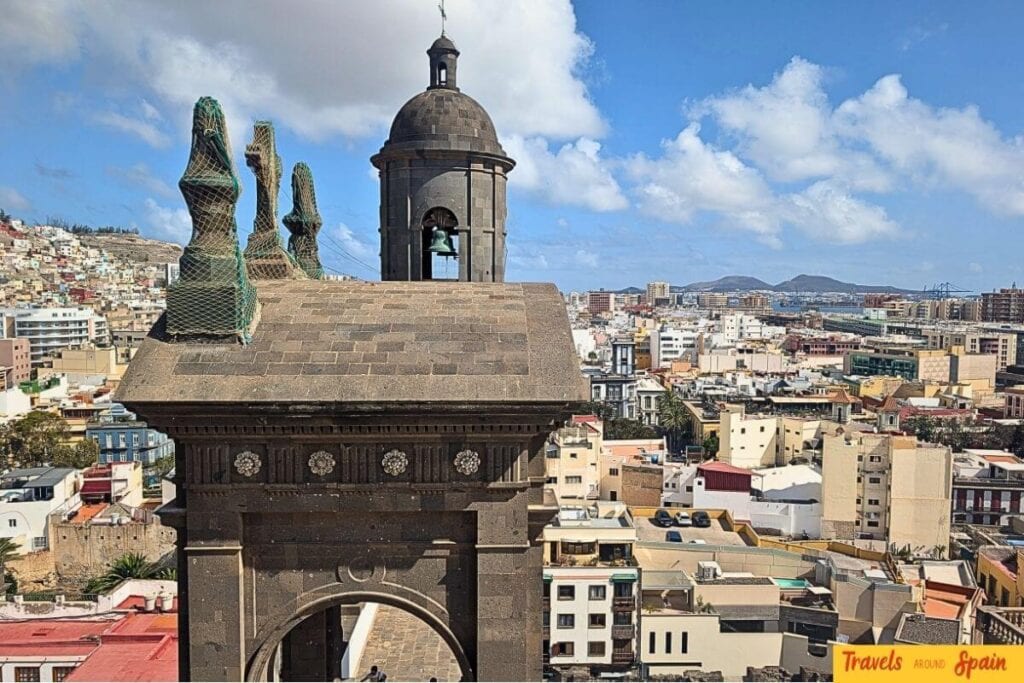
This is when Gran Canaria truly shines as a winter sun destination. You’ll swap heavy coats for t-shirts, experience the unique joy of swimming in the Atlantic in January, and return home with a tan while your friends are still battling frost.
The island buzzes with a special energy during winter – a mix of grateful tourists and locals who know they’re living somewhere extraordinary. February brings the added bonus of Carnival season, when Las Palmas explodes into one of the world’s greatest street parties.
December in Gran Canaria
December is Gran Canaria’s coolest month, but it still beats Europe’s other holiday destinations hands down. Average highs of 21°C and lows of 16°C offer some of the warmest winter sun in Europe. With 6 hours of daily sunshine and only 4 rainy days in total, Gran Canaria in December offers the perfect winter escape.
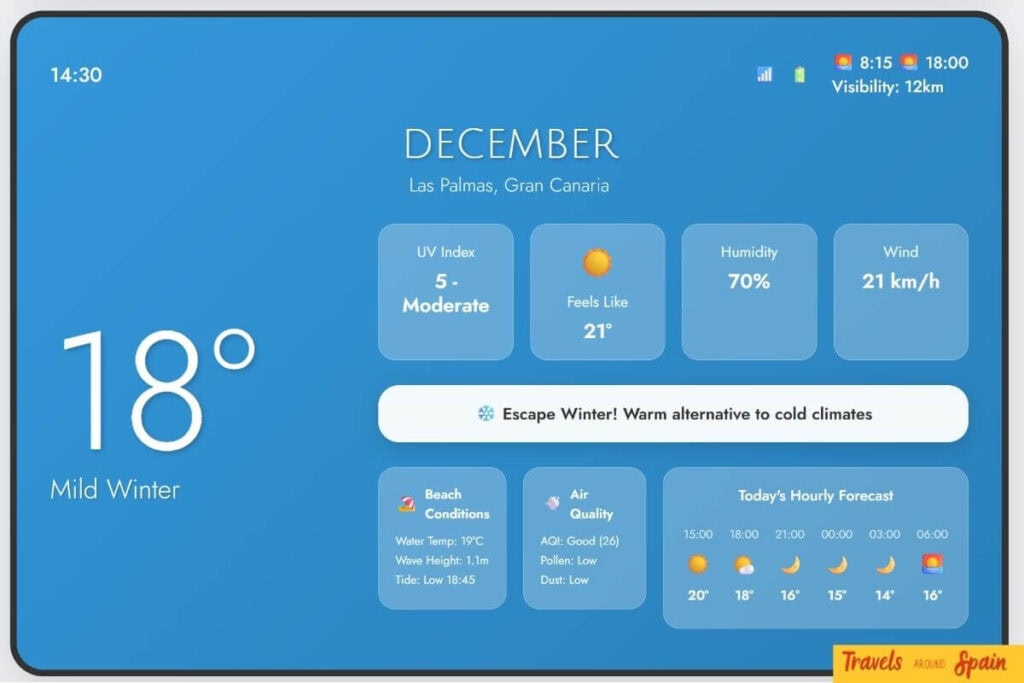
Many people love Gran Canaria in December for its Christmas in shorts and sunshine vibe. It offers the perfect alternative to cold European winters and ideal hiking temperatures for exploring the interior.
For those wanting to explore the island, December offers perfect weather for sightseeing. With the Christmas markets in Las Palmas, there’s a festive atmosphere complete with Spanish holiday traditions. Beach time is still possible but brace yourself as the sea temperature is a little cool at 19°C.
With Christmas demand making prices spike, you can expect to pay high prices if you’re booking in December. It’s the busiest winter month by far, so book 2-3 months ahead. Accommodation fills up fast with long-term visitors.
Stay in the south near Maspalomas for the best weather. It’s warmer here than the north and less prone to rain and clouds. Expect to pay a premium for staying in the south rather than the north.
Packing-wise, you’ll want plenty of layers. The weather is changeable and you’ll need a warm cardigan or jumper for the evenings. A light waterproof jacket is highly recommended to keep you dry during occasional winter showers.
December brings traditional Spanish Christmas celebrations with beautiful nativity scenes (belenes) displayed throughout Las Palmas and local towns. The festive atmosphere is magical, and you’ll experience unique Canarian Christmas traditions while enjoying warm weather that makes outdoor celebrations possible.
Choose December if you want to escape winter completely, don’t mind paying premium prices, and love the idea of Christmas with a difference. It’s perfect for those seeking winter sun, cultural experiences, and active holidays – just book well in advance!
January in Gran Canaria
January is Gran Canaria’s coolest month but it’s still warmer than the majority of Europe with highs of 20°C and lows of 15°C. With 7 hours of sunshine per day, it offers the perfect escape from dismal UK January weather. The sea temperature drops to 18°C – refreshing for hardy swimmers but most visitors prefer land-based activities.

With cold northern hemisphere winters setting in, January is peak winter sun escape season. It’s the best time for hiking around the island’s interior, and with almond blossom season beginning, you’ll capture stunning photo opportunities in the mountain villages.
January is ideal for cultural sightseeing that Gran Canaria has to offer. The cooler temperatures make exploring Las Palmas and the island’s beautiful small villages much more comfortable. For surfing enthusiasts, January brings peak winter surfing conditions – head to the north coast around Las Palmas for the biggest waves.
January features the magical Three Kings Parade on January 6th, where locals celebrate Epiphany with spectacular camel processions through Las Palmas. The Almond Blossom Festival also begins in mountain villages, creating picture-perfect scenes.
As with December, January suffers from high-season pricing and busy crowds of winter sun seekers. Book accommodation well in advance and research restaurants early. Pack layers for cool evenings – think t-shirts for sunny days and warm cardigans for 15°C nights.
Choose January if you want guaranteed winter sun, perfect hiking weather, and authentic cultural experiences, but don’t mind paying premium prices for the privilege.
February in Gran Canaria
February brings Gran Canaria’s coolest temperatures of the year, with highs of 21°C and lows of 16°C, but it’s still beautifully mild compared to the European winter you’re escaping. The sea temperature drops to 18°C – the coolest for swimming but still manageable for hardy souls. With 7-8 hours of daily sunshine, it’s the perfect antidote to grey February days back home.

The star attraction of February is Carnival – Las Palmas hosts the world’s second-largest carnival after Rio. The streets explode with colorful parades, elaborate costumes, and infectious music that continues well into the night. However, this popularity comes at a price – accommodation books out 6+ months in advance and prices soar during carnival weeks.
February offers ideal conditions for hiking with comfortable temperatures and minimal rainfall. The cooler weather makes exploring the interior mountains a joy, while beach time is still possible for those who don’t mind a refreshing dip. Winter swells also make this an excellent time for surfing.
Pack layers – you’ll need t-shirts for sunny days but warm clothes for cooler evenings. Don’t forget a carnival costume if you plan to join the festivities! Be aware that calima (Sahara dust storms) can occasionally occur.
Choose February if you love cultural celebrations, want to escape winter, and don’t mind paying premium prices for an unforgettable carnival experience.
Spring Season: Perfect Weather Begins
Spring in Gran Canaria is when the island truly shows why it’s called the “Island of Eternal Spring.” From March through May, you’ll experience some of the most perfect weather conditions anywhere in Europe, with temperatures gradually warming from a comfortable 22°C in March to an ideal 25°C by May.
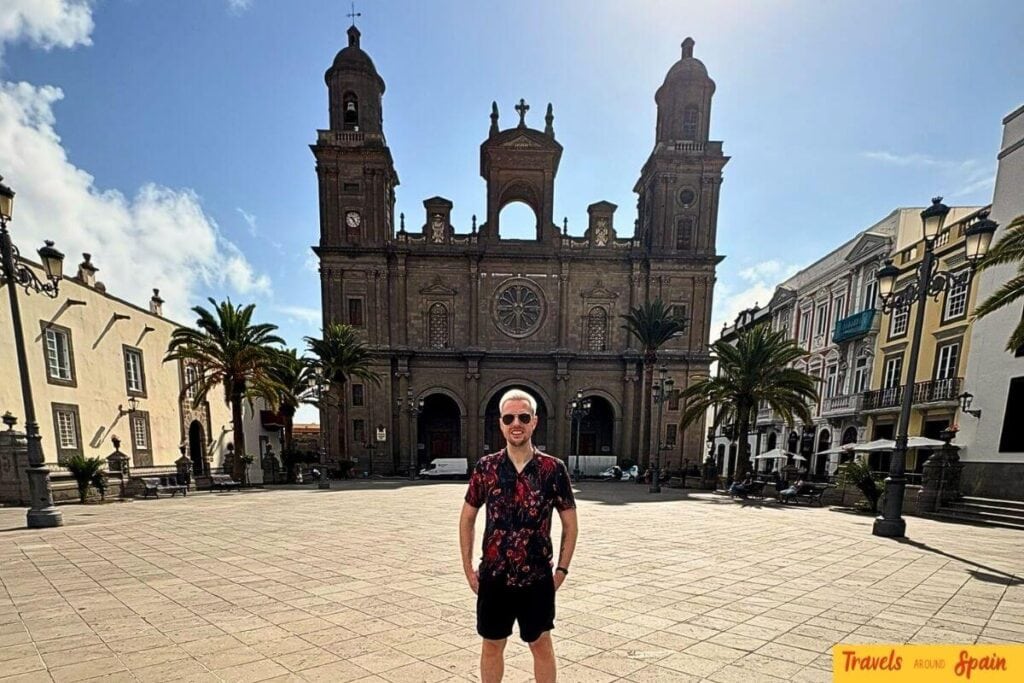
What makes spring so special is the perfect balance it offers. You’ll enjoy increasingly warm and sunny days without the intense heat of summer, while the sea temperatures steadily rise from a refreshing 19°C to a comfortable 21°C. Rainfall becomes virtually non-existent, and you’ll benefit from 8-10 hours of daily sunshine.
Spring is ideal for active travellers who want to experience everything Gran Canaria has to offer. The moderate temperatures make hiking the island’s dramatic mountain trails a pleasure rather than an endurance test, while the warming seas become increasingly inviting for swimming and water sports. You can comfortably explore charming inland villages, cycle coastal routes, or spend entire days on the beach without the overwhelming heat of peak summer.
From a practical standpoint, spring offers excellent value for money. You’ll avoid both the winter sun premium and summer peak pricing, while crowds remain manageable throughout most of the season. The island comes alive with blooming flowers and outdoor festivals, creating a vibrant atmosphere that perfectly complements the improving weather.
March in Gran Canaria
March marks the beginning of spring in Gran Canaria, with temperatures rising to a comfortable 22°C during the day and 17°C at night. The sea warms slightly to 19°C, making swimming more appealing, while you’ll enjoy 8 hours of daily sunshine with minimal rainfall.

As someone who’s visited Gran Canaria multiple times, I consider March one of the most underrated months. The weather is absolutely perfect for outdoor activities without the intensity of summer heat. The island begins to bloom with spring flowers, creating stunning landscapes perfect for photography and hiking.
March offers the perfect balance of good weather and fewer crowds. While early March might still catch the tail end of carnival celebrations, the rest of the month sees a significant drop in tourist numbers. This means better value for money and more space to enjoy the beaches and attractions.
Hiking enthusiasts will love March – the temperatures are ideal for tackling challenging trails like Roque Nublo or exploring the dramatic valleys. Beach lovers can enjoy comfortable sunbathing with pleasant sea breezes, though you might want a light cover-up for windier coastal areas.
Pack light layers – summer clothes for the day with a cardigan for evenings. Easter dates can affect prices and crowds, so check the calendar when planning.
Choose March if you want perfect weather, good value, and don’t mind slightly cooler sea temperatures. It’s ideal for active travellers and those seeking a peaceful escape.
April in Gran Canaria
April brings delightful spring weather with average highs of 23°C and lows of 18°C – warm enough for beach days but perfect for any outdoor activity. The sea temperature rises to a comfortable 20°C, making swimming much more appealing. With 9 hours of daily sunshine and virtually no rainfall, April offers consistently excellent conditions.
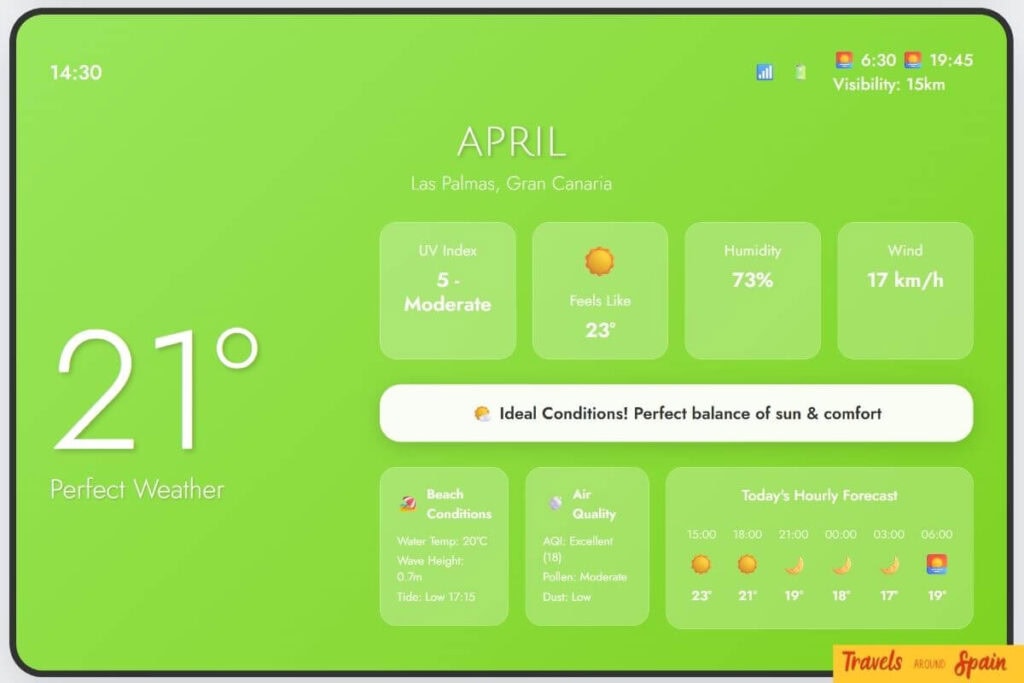
I often recommend April to friends asking about the best value month to visit Gran Canaria. You get fantastic weather without summer price premiums, and the island is beautifully green from winter rains. The tourist crowds are manageable, making it easier to book restaurants and find peaceful spots on the beaches.
April is perfect for all activities – hiking the mountain trails, cycling around the island, exploring charming villages, or simply relaxing on the beach. The temperatures are ideal for morning adventures and afternoon beach time, with comfortable evenings perfect for outdoor dining.
Easter can affect pricing and crowds, so check dates carefully when booking. The island celebrates with traditional processions and local festivities, offering cultural experiences alongside the great weather.
Pack summer clothes with just a light cardigan for breezy evenings. You’ll want comfortable walking shoes for exploring and all your beach essentials for seaside relaxation.
Choose April if you want the perfect combination of excellent weather, good value, manageable crowds, and endless activity options. It’s particularly ideal for couples and active travellers seeking the best of both beach and adventure.
May in Gran Canaria
May delivers near-perfect conditions with temperatures reaching 25°C during the day and staying warm at 19°C in the evenings. The sea temperature hits a comfortable 21°C – ideal for extended swimming sessions and water sports. With 10+ hours of daily sunshine and almost zero rainfall, May offers the reliability of summer without the extreme heat.
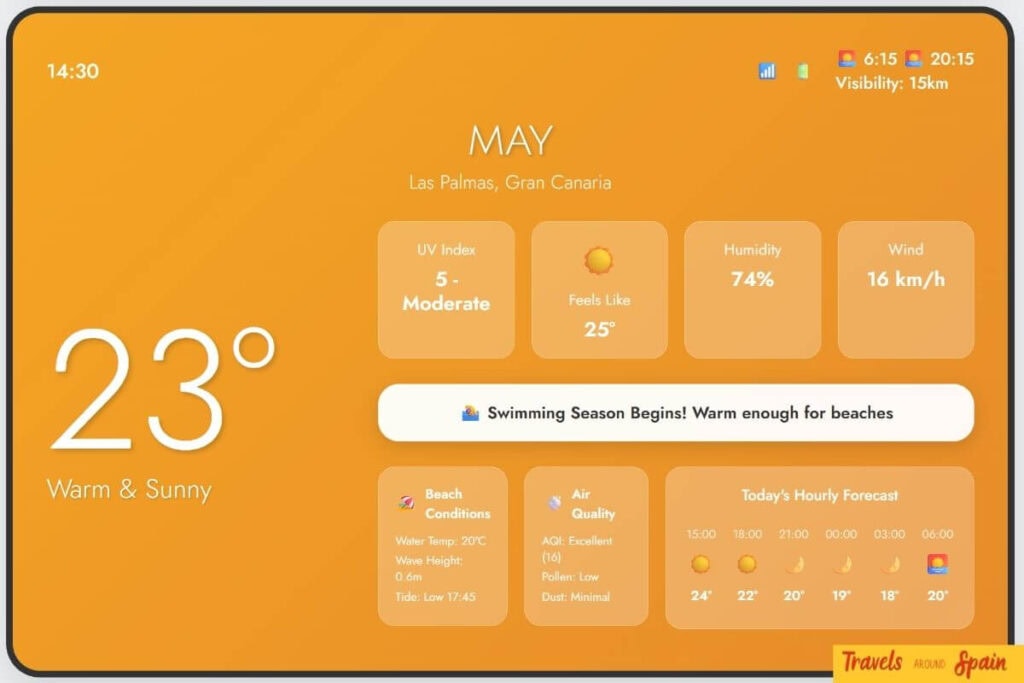
As the last month of excellent value before summer prices kick in, May represents fantastic value for money. The weather is consistently beautiful, making it perfect for those who want guaranteed sunshine but prefer to avoid the peak season crowds and costs that arrive in June.
May is outstanding for all outdoor activities. The sea is finally warm enough for comfortable swimming, while the moderate temperatures make hiking, cycling, and exploring a pleasure. Long daylight hours mean you can pack more into each day, from morning hikes to evening beach walks.
The island comes alive with local festivals and outdoor events. Many restaurants expand their terrace seating, and the evening atmosphere becomes more vibrant as locals and visitors alike embrace the longer, warmer days.
Pack summer essentials – you’ll primarily need light, breathable clothing, swimwear, and sun protection. A light cover-up for breezy evenings is all you’ll need for cooler moments.
Choose May if you want warm sea temperatures, excellent weather, good value before summer prices, and the flexibility to enjoy both beach relaxation and active adventures. It’s perfect for families, couples, and anyone wanting the best of Gran Canaria’s offerings.
Planning Your Gran Canaria Trip
Budget Considerations by Season
When planning your Gran Canaria trip, timing can dramatically impact your budget. Accommodation costs can vary by 40-60% between peak and off-season periods, making your travel dates crucial for value-conscious travellers.
Peak Season Pricing
Peak season pricing hits hardest during December through February (winter sun seekers) and July through August (European summer holidays). Carnival week in February commands the highest prices – accommodation can cost double normal rates.
Best Value Windows
The best value months are November, March, and April, offering excellent weather with 20-30% savings on accommodation. Mid-April through May provides perfect balance of great weather and reasonable prices before summer premiums kick in.
Flight Booking Strategy
For UK flights, November and March typically offer the cheapest fares, while December and August command premium prices. Book 2-3 months ahead for most seasons, but winter sun trips need earlier planning.
For flight booking strategies, check out my guide How to Book a Flight to Madrid for the Best Price – the same principles apply to Gran Canaria flights.
Best Activities Throughout the Year
Gran Canaria’s stable climate makes most activities possible year-round, but certain seasons offer optimal conditions for specific experiences.
Hiking and outdoor adventures shine during October through May when temperatures stay between 20-25°C. Spring (March-May) brings blooming landscapes, while autumn (September-November) offers clear mountain views and comfortable conditions.
Beach and water activities peak from June through October when sea temperatures reach 21-24°C. Swimming is possible year-round, but most find winter’s 18°C sea temperature refreshing rather than inviting.
Cultural experiences work beautifully in winter months when museums and historic sites are less crowded. February’s Carnival and June’s San Juan celebrations are unmissable cultural highlights worth planning around.
Gran Canaria is also particularly welcoming to all travelers – if you’re interested in LGBTQ+ friendly destinations in Spain, check out Is Spain Gay Friendly? 11 Best Gay Friendly Places To Visit.
Photography enthusiasts should target spring for wildflowers, autumn for clear skies, and winter for dramatic cloud formations over the mountains. The golden hour light is consistently excellent thanks to the island’s position.
Surfing benefits from winter swells (November-March), while cycling and coastal walks are most comfortable during the moderate temperatures of spring and autumn. Whatever your interests, timing your visit around optimal conditions enhances every Gran Canaria experience.
What to Pack for Each Season
Packing for Gran Canaria varies surprisingly little between seasons thanks to the stable subtropical climate. Summer (June-August) requires light clothing, swimwear, high SPF sunscreen, and breathable fabrics for hot days.
Spring and autumn (March-May, September-November) need similar summer items plus light layers for cooler evenings – a cardigan or light jacket is essential. Winter (December-February) still focuses on summer clothes for warm 21°C days but requires warmer layers for 16°C nights.
Year-round essentials include comfortable walking shoes, sun protection, and a light waterproof jacket for occasional showers. The key is smart layering – Gran Canaria’s diverse microclimates mean you can experience beach weather and mountain coolness in the same day.
Pack light and focus on versatile pieces that work across different temperatures and activities.
Where to Stay: Choosing Your Base in Gran Canaria
Choosing your base can make or break your Gran Canaria experience. The south coast offers the best weather and beach resorts, perfect for relaxation and winter sun. Las Palmas in the north provides urban culture, restaurants, and authentic city life. The mountainous interior suits hikers and those seeking cooler temperatures.
Most visitors choose based on weather priorities – south for guaranteed sunshine, north for cultural experiences, or split your stay to experience multiple regions during longer trips.
The South Coast: Best for Beach Holidays and Winter Sun

The south coast offers Gran Canaria’s most reliable weather, typically 2-3°C warmer than the north, with less rainfall. Centred around Maspalomas, Puerto Rico, and Playa del Inglés, this region is ideal for winter sun seekers and, beach-focused holidays.
Expect excellent resort facilities, consistent sunshine, and protection from trade winds year-round.
The North Coast: Culture, Authenticity and City Life
The north coast centres around Las Palmas, Gran Canaria’s vibrant capital, offering world-class museums, the historic Vegueta district, and authentic Canarian dining.
While slightly cooler and wetter than the south, it provides genuine local culture away from resort areas. Choose the north for cultural immersion, city conveniences, and authentic experiences, particularly appealing during summer when temperatures are more comfortable.
The Interior: Mountain Villages and Hiking Access
The mountainous interior offers a completely different Gran Canaria experience with charming villages like Tejeda and Artenara. Temperatures are 6-10°C cooler than the coast, making this ideal for summer hiking when coastal areas become too hot.
Choose interior accommodation for access to volcanic landscapes, traditional mountain culture, and year-round hiking trails like Roque Nublo and Pico de las Nieves.
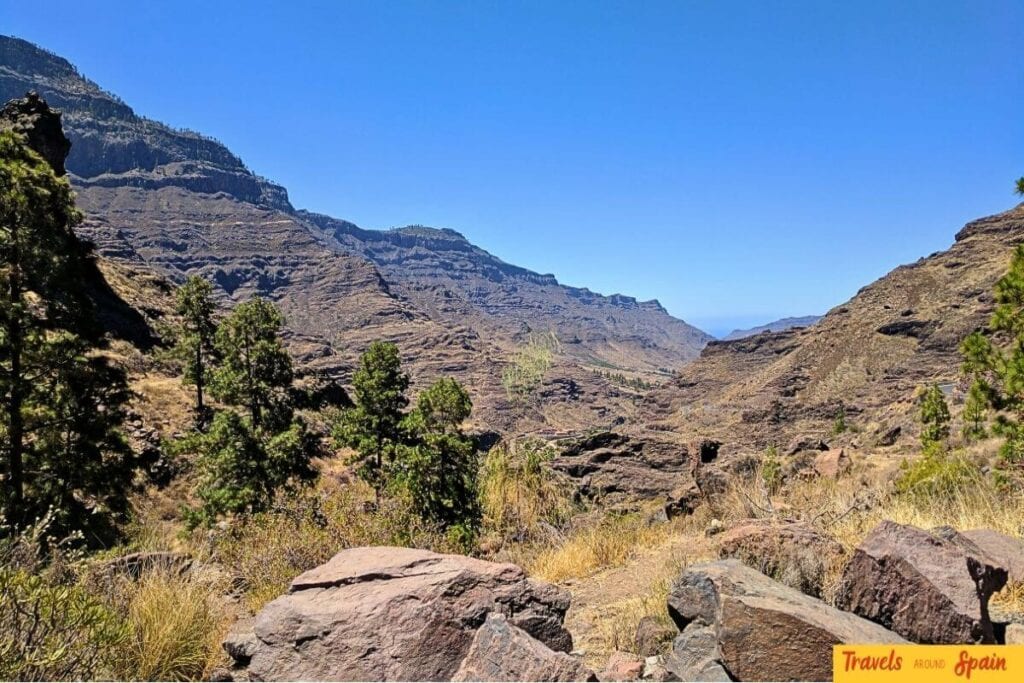
Special Events and Festivals Calendar
Gran Canaria’s festival calendar can significantly impact your travel experience, either enhancing it with incredible cultural events or affecting availability and prices.
Las Palmas Carnival (February) is the island’s biggest celebration – Europe’s largest carnival after Venice. Expect weeks of parades, costumes, and street parties, but book accommodation 6+ months ahead as prices double.
San Juan (June 23rd) brings magical midsummer celebrations with beach bonfires and the tradition of jumping over flames for good luck – a truly authentic cultural experience.
Holy Week (March/April) features beautiful religious processions throughout the island, while local village fiestas run from May through September, offering intimate glimpses into traditional Canarian culture.
Fiesta del Carmen (July 16th) honours the patron saint of sailors with coastal celebrations, and various harvest festivals occur in autumn.
Pro Tip – Check festival dates before booking – they can transform your trip into an unforgettable cultural experience or create crowds and inflated prices if you’re seeking a quiet getaway.
FAQs
What’s the best month to visit Gran Canaria?
The best month to visit Gran Canaria depends entirely on your priorities. If you’re looking for perfect temperatures with great value and fewer crowds, choose March-May. For those looking for the warmest sea temperature and ideal hiking weather, autumn is the season for you.
For beach lovers, you won’t go wrong with the summer months, whilst those seeking to escape the harsh winters should book to come in December to February.
What’s the cheapest time to visit Gran Canaria?
The cheapest time to visit Gran Canaria is November, followed closely by March-April. Accommodation prices in November drop by 40-50% compared to peak season, and with lower flight prices from the UK, this is the month to grab a bargain.
March and April also benefit from cheaper accommodation, and if you can avoid the Easter spike, you can grab yourself a deal on flights. These months also hit that weather sweet spot with perfect temperatures for a range of activities.
Is Gran Canaria hot in summer?
Gran Canaria is hot in summer but not as hot as some of Spain’s other regions, like Andalusia or Extremadura. The average temperatures across the summer months of June, July and August range from 21°C to 29°C, making it warm but not oppressive.
With sea temperatures in the mid-20s, it is the perfect time for water sports and beach activities. Evening temperatures are also pleasant, making it the ideal time to visit Gran Canaria.
Can you swim in Gran Canaria in winter?
Yes, you can swim in Gran Canaria in winter. Sea temperatures drop in winter but still average around 18°C -20°C in December and January. The water will feel refreshing, but it is still a good temperature for shorter swims. Locals swim year-round, and the temperatures are higher than in the Mediterranean in winter, so take the plunge and dive in!
Does it rain much in Gran Canaria?
It does not rain often in Gran Canaria, especially when compared to other places in Spain and Europe. The island averages 150mm of rainfall a year, making it one of Europe’s driest destinations.
June to August are the driest months with 0mm of rain, whereas December receives around 33mm. Usually, the rain comes in the afternoon and is brief before brightening up again.
Which part of Gran Canaria has the best weather?
The south coast of Gran Canaria has the best weather. This popular coast with tourists has the hottest temperatures on the island, often being a couple of degrees hotter than the capital Las Palmas. It’s no wonder that the main tourist hubs are located here!
Final Recommendations: Choosing Your Perfect Time
After exploring every month of the year, the truth is there’s no single “best” time to visit Gran Canaria – it entirely depends on what you prioritize. The island’s year-round subtropical climate means you’re guaranteed pleasant weather whenever you visit, but each season offers distinct advantages.
If weather is your top priority, aim for April through October when temperatures are consistently warm and rainfall is minimal. For the ultimate beach experience, September and October offer the warmest sea temperatures after months of summer heating, while June through August guarantee hot, sunny days.
Budget-conscious travelers should target March, April, or November when accommodation costs drop significantly and flight prices are more reasonable. However, avoid December through February and July through August when winter sun seekers and summer holidaymakers drive prices up.
Culture enthusiasts have specific windows – February for the incredible Las Palmas Carnival, June for San Juan celebrations, or the quieter winter months for a more authentic local experience without tourist crowds.
My own choice of June reflects my priorities: reliable sunshine for beach days, warm sea temperatures for swimming, and long daylight hours for exploration, even if it means paying summer prices and dealing with crowds. The key is being honest about what matters most to you – perfect weather, cultural experiences, value for money, or peaceful beaches – then choosing accordingly.
Best Time for Beach Lovers
June through October is your golden window for the ultimate beach experience. The sea temperature reaches its peak at 23-24°C in September and October – genuinely warm rather than just refreshing. These months offer the warmest water after the summer sun has heated the Atlantic for months.
June through August guarantees hot, sunny weather perfect for all-day beach sessions, though you’ll share the sand with peak season crowds. September is the sweet spot – combining the year’s warmest sea temperatures with decreasing tourist numbers as families return home. For comfortable swimming year-round, the sea never drops below 18°C even in winter, but most people find 20°C+ much more enjoyable for extended water activities. If you’re a hardy swimmer, you can enjoy Gran Canaria’s beaches any month, but for luxurious, warm water experiences, stick to late summer and early autumn.
Best Time for Hikers and Active Travellers
October through May offers ideal conditions for hiking and outdoor adventures. During these months, daytime temperatures range from 20-25°C – perfect for tackling challenging trails without overheating. The cooler months also bring clearer skies, offering stunning mountain views often obscured by summer haze.
March through May is particularly outstanding for hikers. Spring brings blooming wildflowers, comfortable temperatures, and longer daylight hours for extended adventures. October and November are equally excellent, with stable weather and the bonus of warm sea temperatures for post-hike swims.
Avoid July and August for serious hiking – midday temperatures can reach 29°C+, making mountain trails uncomfortable and potentially dangerous. If you must hike in summer, start at dawn and finish by 10am, then spend afternoons on the beach.
Best Time for Budget Travellers
November, March, and April offer the best value for money, with accommodation costs 20-40% lower than peak season. November is particularly budget-friendly but comes with slightly more unpredictable weather as autumn transitions to winter.
Avoid December through February when winter sun seekers drive prices sky-high, and July through August when European summer holidays create peak demand. Carnival week in February sees the highest prices of the year – accommodation can cost double normal rates.
For flights from the UK, November and March typically offer the cheapest fares, while December and August command premium prices. Mid-week departures and avoiding school holidays can save hundreds on family trips.
April offers the ultimate sweet spot – excellent weather, manageable crowds, and pre-summer pricing make it ideal for budget-conscious travellers who don’t want to compromise on conditions.
Best Time for Cultural Experiences
February is unmissable for culture lovers, featuring the spectacular Las Palmas Carnival – Europe’s largest carnival after Venice. The entire city transforms with parades, music, and celebrations lasting several weeks. Book accommodation months in advance as this is the island’s biggest cultural event.
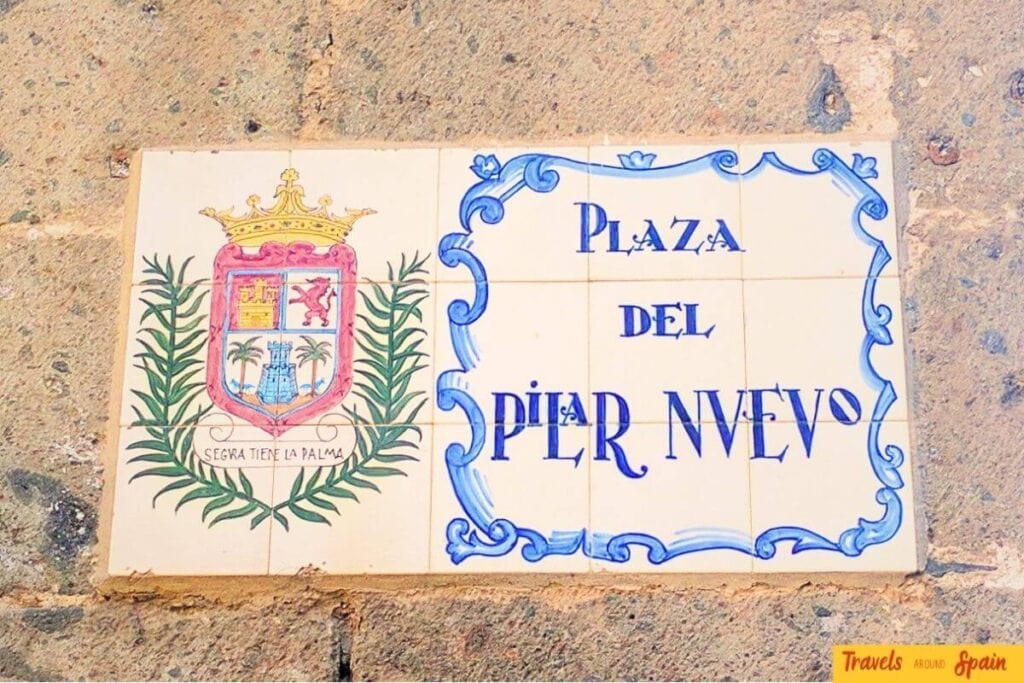
June through August brings vibrant summer festivals, including the magical San Juan celebrations on June 23rd with beach bonfires and traditional rituals. Many coastal towns host local fiestas during summer months, offering authentic glimpses into Canarian traditions.
Winter months (November-February) provide the most authentic cultural experience. With fewer tourists, you’ll experience genuine local life – from traditional markets to neighbourhood celebrations. Museums and cultural sites are less crowded, allowing for more meaningful visits.
Holy Week (dates vary) features beautiful religious processions throughout the island, while October often hosts cultural festivals including music and arts events in Las Palmas. The key is researching specific dates for events that interest you most.
Final Thoughts: Best Time to Visit Gran Canaria
As you can see, Gran Canaria truly is a year-round destination. With over 300 days of sunshine annually, there really is no ‘wrong’ time to visit – each month simply offers different opportunities to experience the island’s many faces.
I was primarily looking for a beach holiday – sun, sea, and relaxing by the pool. This is exactly why June topped my list (plus I managed to grab that £350 bargain!). But researching this comprehensive guide has opened my eyes to Gran Canaria’s incredible diversity throughout the seasons – from winter hiking and carnival celebrations to autumn’s perfect swimming conditions.
If you’re considering a trip to Gran Canaria, start by identifying your priorities and work from there. Whether you want a beach escape like me, plan to hike through stunning volcanic landscapes, or dream of experiencing carnival magic, your perfect month is waiting. The hardest decision isn’t whether to go, but when to go.
Once you’ve chosen your ideal month, don’t forget to check out my guide on what to pack for Gran Canaria in June, complete with a free downloadable packing guide. While focused on summer travel, it provides an excellent foundation for planning any season’s wardrobe.
If Gran Canaria has inspired you to explore more of Spain, take my Which Spanish City Should You Visit? Quiz to discover your perfect next Spanish destination.
Whenever you choose to visit, Gran Canaria won’t disappoint – this truly special island has something magical to offer every month of the year.
About Me

My name is Liam and I’m the owner and author of ‘Travels Around Spain’. I have been obsessed with Spain ever since my first visit 35 years ago. I am on a mission to visit and discover every part of this beautiful country and share all my hints and tips with you all.
Read more about my journey by clicking here.











